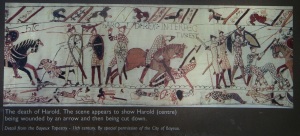Archive for September 2012
 Christmas Eve, December 24, 1818, Oberndorf, Austria. “Silent Night,” the new Christmas carol with lyrics composed by Father Joseph Mohr and score composed by local school headmaster Franz Gruber, is sung for the first time. In an untimely turn of events, the church organ is broken, so, at the last minute the composition is set to guitar. (This was long before the folk guitar mystique of Pete Seeger or the campfire aura strumming of Kumbaya.) What was intended to be an august, reverent introduction of a new Christmas hymn with swelling organ embellishment was instead a gentle, intimate rendering of a heart-warming carol plucked quietly on six strings.
Christmas Eve, December 24, 1818, Oberndorf, Austria. “Silent Night,” the new Christmas carol with lyrics composed by Father Joseph Mohr and score composed by local school headmaster Franz Gruber, is sung for the first time. In an untimely turn of events, the church organ is broken, so, at the last minute the composition is set to guitar. (This was long before the folk guitar mystique of Pete Seeger or the campfire aura strumming of Kumbaya.) What was intended to be an august, reverent introduction of a new Christmas hymn with swelling organ embellishment was instead a gentle, intimate rendering of a heart-warming carol plucked quietly on six strings.
The original Nikolaus-Kirche in Oberndorf was demolished in the early 1900’s as the result of a flood. The now famous “Stille Nacht” Chapel was built in its place shortly thereafter and has been the site of a tourist tradition ever since. One Christmas Eve, I stood with a few friends and hundreds of others in the frigid clear cold of an Alpine night outside the chapel. (It is far too small to accommodate crowds inside). All was calm, and all was bright. A codified ceremony of generations proceeded, culminating with the singing of Silent Night (in German, of course) accompanied by guitar. It was not a Woodstock moment, nor a mountaintop experience, but it was quaint and sentimentally uplifting. It got me to thinking about times when things do not turn out as expected. Here we all were, freezing our knuckles, observing a century old tradition because long ago the organ was broken.
Consider how often in life the thing that was planned, and does not happen, is surpassed by the unexpected substitute that succeeds marvelously and may even gain legendary status. This is not an uncommon turn of events; it happens all the time in circumstances that are both trivially ironic and those that are of geo-political import. Call it the Will of God, call it fate, call it what you will. When one considers how frequently this phenomenon is repeated – in matters both great and small – it ought to evoke two responses.
First, humility in our intentions. Even our best-laid plans often end up manifesting themselves differently than envisioned. Sometimes the results are better than we could have imagined or deserved. Second, modesty in our expectations. Many things we plan and try to micro-manage down to the nano-level of strategy end up proceeding far differently than we thought. This is true in things like careers, marriages and wars. Since things sometimes end up worse than projected, modest expectations at the outset would seem a reasonable posture.
Humility. Modesty. These are offensive words in an era driven by a quest for self-satisfaction and arrogant claims of rightness. But perhaps long ago Joseph Mohr had it right. “Glories stream from heaven afar.” They come to us, often unbidden and beyond our merit. And when our human foibles result in a mess, well, Mohr reminds us of a “dawn of redeeming grace.” Arrogance cannot recognize such. But humility can.

The Getreidegasse, Salzburg, Austria
Many Medieval cities in Europe were constructed as a network of narrow streets with several story buildings lining them like walls of a gorge. Human foot traffic and animal-drawn carts flowed through them like streams in search of a preordained gradient. That the store-front walls of these citified canyons were raised so high is easy to explain: five hundred years ago it was cheaper to build up than out. And so, some of the ancient streets in the Old Town section of Salzburg, Austria, are almost claustrophobic. Any on-coming traffic, even if it is merely fellow pedestrians, creates a logistical immediacy, both in terms of navigation and human interface. Depending on one’s temperament or mood, walking the Getreidegasse can be either an intimate experience or an intimidating one.
The Getreidegasse, also known as “Grain Lane”, was once a market street, but since World War II it has taken on the mien of the busiest shopping street in the Old Town and a mecca of tourists. There is now, and has been for centuries, a significant hub-bub on this ancient lane. At house number Nine on the Getreidegasse Wolfgang Amadeus Mozart was born on January 27, 1756, and he lived there until he was seventeen. It’s a typically narrow, creaky old wooden home laden with memorabilia and history. The living space is spread upward through several floors of slender rooms, steep stairways and tight passageways. Young Wolfgang lived there when he composed his earliest works, starting at age four! Before he left Salzburg as a teenager he had composed dozens of symphonies and piano and violin concertos, many of which are still performed in our era.
To this day one can take in a Mozart dinner concert in the cellar of old St. Peter’s Church, where period string instruments and costume clad opera singers perform his works. Sitting in this old stone hall, listening to Mozart on the night of his birthday, was a most pleasing and humbling experience. His brilliance started so early, he composed so much, and then he died so young. But, emerging from the restricting environs of the Getreidegasse, graduating to Vienna, the epitome of arts in his day, and then broadcasting his music across three centuries and every continent, W. A. Mozart is a paradigm of the notion of expansive imagination. His craft began in cramped, unconducive quarters and eventually pushed the extremes of artistic creativity, touching the most intimate chords of the human soul.
Not infrequently, the keenest of observations, the most creative of insights, and the clearest ideations of the human species have emerged from highly unfavorable surroundings. Perhaps the best in any of us has emerged from some such corner of least expectancy.
 First there is the wheezy etching sound of a diamond wheel scoring the surface,
First there is the wheezy etching sound of a diamond wheel scoring the surface,
then tap, tap, and clink, the glass breaks predictably along the indicated path.
The grinder wheel whirs as the edges of the raw cut shards are smoothed away,
dross removed in the mist of lubricating water spray.
Now it is snip, file, straighten and bend the aitch-shaped caming lead
to fit the rigidly linear or sensuously curving profile of the pieces.
Finally, smoldering solder dabs the joints of lead to freeze the structure
in a permanent design of color and texture.
Still, the essential element, the central character, in this play of art is missing;
the design, for all the vision and craft invested, is still, lifeless.
One more eternal, cosmic component is needed, or, if yet lacking,
the entire composition is for naught, worthless.
Stained glass has no charisma without light; it remains dark, dreary and dulled;
but light brings life to the glass, whether brilliant, indirect or occluded.
Moreover, the character of light is altered by stained glass.
Light itself has no color until it passes through
this prismic veil of fashioned lens to don its fragment of designated hue.

 The Bayeux Tapestry is one of the most ancient and valued artifacts in the Western world. It depicts fifty scenes of the Battle of Hastings in 1066 at which the Saxon King of England, Harold, was slain in battle by forces of his half-brother, William, Duke of Normandy, who has since been known as William the Conqueror. The “tapestry” was made in England (not in Bayeux, France) in the 1070s to commemorate the battle, but after a journey of unknown nature was later discovered in Bayeux Cathedral where it remains.
The Bayeux Tapestry is one of the most ancient and valued artifacts in the Western world. It depicts fifty scenes of the Battle of Hastings in 1066 at which the Saxon King of England, Harold, was slain in battle by forces of his half-brother, William, Duke of Normandy, who has since been known as William the Conqueror. The “tapestry” was made in England (not in Bayeux, France) in the 1070s to commemorate the battle, but after a journey of unknown nature was later discovered in Bayeux Cathedral where it remains.
The Bayeux Tapestry is not actually a tapestry at all; it is a linen cloth of colossal proportions embroidered with tiny colored woolen yarns. It spans nearly two hundred and thirty feet and is comprised of nine panels of varying lengths, some over forty feet long, which depict various scenes of the famous battle.
While each panel has its own theme and scheme, the same colors are repeated throughout the entire configuration – russet, blue-green, dull gold, olive green, dark blue, sage, light yellow, orange and black. The panels illustrate scenes of battle and triumph, valor and suffering, victory and death. While the subjects of the scenes change, the colors of the threads flow from one panel to the next featuring distinguishable details of historic account in a unifying interplay of hues.
Our lives, too, are stitched with the hues of joy and tragedy, success and failure, healing and brokenness. The colors of our lives are tinted by our discoveries and relationships. The hues of our scenes bear striking resemblances even though our particular experiences are unique.
I once knew a woman whose son committed suicide. As part of her grief and healing she wove an abstract tapestry of varying stylistic elements through which ran a single strand of color, representing her son’s life, uniting the tension of the parts in a harmonious whole.
Curiously, the last panel of the original Bayeux Tapestry has been mysteriously missing for centuries, later adaptations having been added to the original composition in a superimposed attempt at approximated completion.
None of us knows in which colors the final scene of our life will play out. But the common threads, woven matrices of relationships, and strands of growth and discovery that define us so far mark each of us as a single filament in a bigger fabric.
 Christmas Eve, December 24, 1818, Oberndorf, Austria. “Silent Night,” the new Christmas carol with lyrics composed by Father Joseph Mohr and score composed by local school headmaster Franz Gruber, is sung for the first time. In an untimely turn of events, the church organ is broken, so, at the last minute the composition is set to guitar. (This was long before the folk guitar mystique of Pete Seeger or the campfire aura strumming of Kumbaya.) What was intended to be an august, reverent introduction of a new Christmas hymn with swelling organ embellishment was instead a gentle, intimate rendering of a heart-warming carol plucked quietly on six strings.
Christmas Eve, December 24, 1818, Oberndorf, Austria. “Silent Night,” the new Christmas carol with lyrics composed by Father Joseph Mohr and score composed by local school headmaster Franz Gruber, is sung for the first time. In an untimely turn of events, the church organ is broken, so, at the last minute the composition is set to guitar. (This was long before the folk guitar mystique of Pete Seeger or the campfire aura strumming of Kumbaya.) What was intended to be an august, reverent introduction of a new Christmas hymn with swelling organ embellishment was instead a gentle, intimate rendering of a heart-warming carol plucked quietly on six strings.



